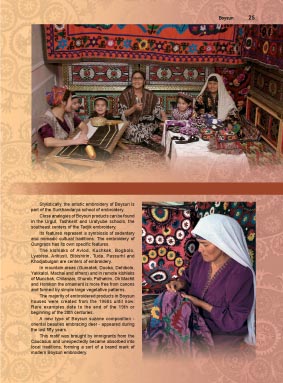Embroidery represents one of the most remarkable phenomena of Boysun folk art. It decorates the interior of every traditional house. Especially popular are wall embroideries, or suzane, narrow frieze bands, or УzardevorФ and УdjoinamazФ, or pray mats. The cheerful colours and compositions of Boysun embroideries reflect ideas about the universe, nature, happiness and love. Symbols of the Macro Cosmos: the Sun, the Moon and planets, occupy a central part. The center of the planet is marked by its nucleus in the form of a rosette or a flower branch, or Уdasta-gyulФ. Sometimes the nucleus contains a circle with four colored sectors symbolizing the four seasons or the four elements: fire, water, earth and air. Between the УplanetsФ there are floral and vegetative patterns, an almond flower, or tulip, sometimes with stylized birds on branches; swallows and nightingales. The entire composition represents a cosmogram of the ideal world and paradise, or УdjannatФ. Some embroideries have stylized pictures of a winged angel, or УfarishtaФ. A stripe of УobaФ frames the embroidery; demarcating borders of this fantastic world. As a rule, suzane, zardevor and other types of Boysun embroidery are included in the dowry. They represent an artistic realization of prayers for blessing and the happiness of the future young family.
![]()
√лавна¤ страница.
—татьи и доклады
Ёлектронна¤ библиотека
осмограммы ÷ентральной јзии
Samarkand
(каталог на англ.¤з.)
Boysun
(каталог на англ.¤з.)
![]()
![]()
Boysun. Masterpieces of Central Asia
Stylistically, the artistic embroidery of Boysun is part of the Surkhandarya school of embroidery. Close analogies of Boysun products can be found in the Urgut, Tashkent and Uratyube schools, the southeast centers of the Tadjik embroidery. Its features represent a symbiosis of sedentary and nomadic cultural traditions. The embroidery of Qungrads has its own specific features. The kishlaks of Avlod, Kuchkak, Bogbolo, Lyabisoi, Arikusti, Bibishirin, Tuda, Passurhi and Khodjabulgan are centers of embroidery. In mountain areas (Gumatak, Duoba, Dehibolo, Yakkatol, Machai and others) and in remote kishlaks of Munchak, Chilanzar, Shurob, Pulhakim, Ok Machit and Homkon the ornament is more free from canons and formed by simple large vegetative patterns. The majority of embroidered products in Boysun houses were created from the 1960s until now. Rare examples date to the end of the 19th or beginning of the 20th centuries. A new type of Boysun suzane composition Ц oriental beauties embracing deer-appeared during the last fifty years. This motif was brought by immigrants from the Caucasus and unexpectedly became absorbed into local traditions, forming a sort of a brand mark of modern Boysun embroidery.

